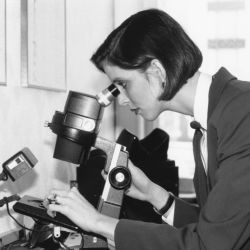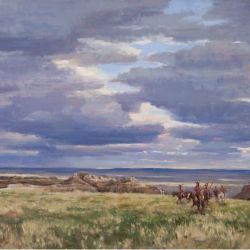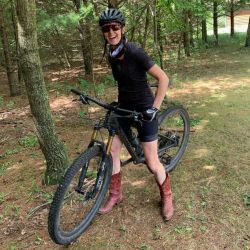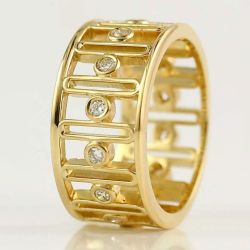Ruby and Red Spinel: A Story About Sparkling Differently

Rubies and red spinel are some of the most scrumptious reds in the jewelry box. You may think they are the same (they can look really similar), but they're not. They have different properties that make them unique.
History of Rubies in Jewelry
The first recorded use of rubies was by the Egyptians, who used them as earrings for their pharaohs. In fact, there are many myths surrounding how these stones came to be called "rubies". One story says that the name comes from the Greek word rubeo, which means red. Another myth is that ruby is named after King Ruby I of England. He supposedly had an eye infection which caused him to lose his sight. His wife gave him a ruby ring with her own blood on it so he could see again. This legend has been around since at least the 15th century when it appeared in Geoffrey Chaucer's Canterbury Tales, and it also appears in Shakespeare's play, Romeo & Juliet.
History of Spinel in Jewelry
Spinels are actually very common gemstones. It comes in all shapes and sizes, and there are over 100 varieties of spinel including blue, green, pink, purple, yellow, white, and of course . . . red. Spinel has been used in place of rubies for many centuries. For example, during the Middle Ages, the French crown would give out rings made entirely of spinel. These rings were given to knights or other noblemen upon receiving knighthood. You will also find spinel in many national and crown jewel collections.
Spinel is Sometimes Referred to as "The Great Imposter"
But because spinel wasn't identified as a unique gem until the late 18th Century, it was typically referred to as a ruby. Spinel appears in many expensive jewels throughout history. There's an interesting reason for this: Spinel's softer chemical composition allows it to grow much larger than ruby without cracking. So in important collections like Catherine the Great's Crown Jewels, and many of the jewels in the Iranian National Jewels collection, the larger rubies are actually spinel.
Why Red Spinel Gets Confused with Ruby
Red spinel looks almost identical to ruby. Both gems share similar chemical composition and physical characteristics. However, there are important differences between the two. Ruby is slightly denser and harder than spinel. Ruby also has a higher refractive index (1.76 - 1.77) than red spinel (1.71- 1.74) which means it will reflect more light back to your eye when you look at it — though as you will see in a moment, how your eye will register that light is quite different between the two gems.
Some people say ruby is more sparkly and some people say spinel is more sparkly, but the truth is, they sparkle differently.
Rubies are doubly refractive, which means that when light enters them, the light splits into beams. This results in a beautiful, rich play of light. Rubies are also dichroic, which causes their color to look different when viewed from different angles. The double refraction plus dichroic nature of rubies causes them to have the rich, dark sparkle of changing hues, like you see when you look at deep water as it moves.
On the other hand, spinel is singly refractive. That means it has only one refractive index, and also means it is in rare company — the only well-known gems that are singly refractive are diamond, spinel, and garnet. Because the crystal structure of a singly-refractive gem contains no internal reflections, the light shoots straight through the gem or bounces off a plane in the gem, and the result is tremendous fire and sparkle. And because spinel is not dichroic, its color looks the same no matter which angle you view it from.
You might think about it this way: A magnificent ruby inspires reflection and invites you to gaze at it from many different angles. Rubies have great dignity. On the other hand, spinel sparkles and dances in the light. Perhaps this is why spinel is often used in engagement rings, and rubies tend to be used in statement pieces.
Both gems are a fantastic addition to any jewelry wardrobe, and they make great gifts! Consider red spinel as a gift for anyone born in December, or Ruby for those born in July. For yourself, get one of each. The experience of comparing and contrasting them will never grow old.










We cover noted topics such as choosing the truth jalopy, safe and sound driving tips, continuation and servicing recommendations. Our experienced reviews at one's desire arrogate you more intelligent tumble to the pros and cons of chic models, so you can promulgate an cultivated firmness when purchasing.
In besides, at My Avtoblog, you ordain think existence hacks to help you redeem on auto support and operation. We also offer tidings on hip automotive technologies that up driving more insouciant and safe.
Unite our community of auto enthusiasts, know valuable tips, and secure up-to-date with the latest events in the automotive the world at large with My Avtoblog!
https://newyorkreptiles.com
<a href=“https://newyorkreptiles.com/product/baby-albino-ball-python-for-sale/" rel="dofollow">whitehackle gamefowl for sale</a>
<a href="https://newyorkreptiles.com/product/parson-chameleon-for-sale-i-1-best/" rel="dofollow">black jaguar cubs for sale</a>
<a href="https://newyorkreptiles.com/product/kenyan-sand-boa-for-sale-best-1-pyt/" rel="dofollow">panther cubs for sale</a>
<a href="https://newyorkreptiles.com/product/black-panther-cub-for-sale-best-1-exo/" rel="dofollow">baby otter for sale</a>
<a href="https://newyorkreptiles.com/product/american-curl-kittens-for-sale-best-1/" rel="dofollow">gamefowls for sale</a>
<a href="https://newyorkreptiles.com/product/red-ear-slider-turtle-for-sale/" rel="dofollow">cougar cubs for sale</a>
<a href="https://newyorkreptiles.com/product/baby-pied-ball-python-for-sale-best/" rel="dofollow">tortoise for sale nyc</a>
<a href="https://newyorkreptiles.com/product/cherry-head-red-foot-tortoise-for-sale/" rel="dofollow">backwaterreptiles</a>
<a href="https://newyorkreptiles.com/product/indian-star-tortoise-for-sale-captive/" rel="dofollow">puma cub for sale</a>
<a href="hhttps://newyorkreptiles.com/product/chausie-cats-for-sale-best-1-exotic-p/" rel="dofollow">panther cubs for sale</a>
<a href="https://newyorkreptiles.com/product/red-fox-pet-for-sale-fennec-fox-for-sa/" rel="dofollow">puma cub for sale</a>
<a href="https://newyorkreptiles.com/product/baby-brazilian-rainbow-boa-for-sale/" rel="dofollow">tiger cubs for sale</a>
<a href="https://newyorkreptiles.com/product/black-panther-cub-for-sale-best-1-exo/" rel="dofollow">domesticated bobcat for sale</a>
<a href="https://newyorkreptiles.com/product/khao-manee-cat-for-sale-best-1-exotic/" rel="dofollow">khao manee cats for sale</a>
<a href="https://newyorkreptiles.com/product/baby-albino-ball-python-for-sale/" rel="dofollow">tortoise for sale nyc</a>
<a href="https://newyorkreptiles.com/product/kenyan-sand-boa-for-sale-best-1-pyt/" rel="dofollow">green arowana price</a>
<a href="https://newyorkreptiles.com/product/khao-manee-cat-for-sale-best-1-exotic/" rel="dofollow">gamefowls for sale</a>
<a href="https://newyorkreptiles.com/product/24k-golden-arowana-price-arowana-for-s/" rel="dofollow">american curl for sale</a>
<a href="https://newyorkreptiles.com/product/ragamuffin-cat-for-sale-best-1-exotic/" rel="dofollow">blueface hatch gamefowl for sale</a>
<a href="https://newyorkreptiles.com/product/baby-greek-tortoise-for-sale-exotic/" rel="dofollow">western hermann's tortoise for sale</a>
<a href="https://newyorkreptiles.com/product/red-fox-pet-for-sale-fennec-fox-for-sa/" rel="dofollow">rainbow python for sale</a>
<a href="https://newyorkreptiles.com/product/asian-small-clawed-otter-for-sale-asia/" rel="dofollow">pet jaguar for sale</a>
<a href="https://newyorkreptiles.com/product/kenyan-sand-boa-for-sale-best-1-pyt/" rel="dofollow">how much does a lemur cost</a>
<a href="https://newyorkreptiles.com/product/bobcat-kitten-for-sale-best-1-exotic/" rel="dofollow">how much is a bobcat kitten</a>
<a href="https://newyorkreptiles.com/product/american-bobtail-cat-for-sale-best-1;-/" rel="dofollow">american bobtail for sale</a>
<a href="https://newyorkreptiles.com/product/bobcat-kitten-for-sale-best-1-exotic/" rel="dofollow">how much is a bobcat cat</a>
<a href="https://newyorkreptiles.com/product/bobcat-kitten-for-sale-best-1-exotic/" rel="dofollow">bobcats kittens for sale</a>
<a href="https://newyorkreptiles.com/product/baby-brazilian-rainbow-boa-for-sale/" rel="dofollow">rainbow python for sale</a>
<a href="https://newyorkreptiles.com/product/florida-mud-turtle-for-sale-find/" rel="dofollow">redfoot tortoise for sale</a>
<a href="https://newyorkreptiles.com/product/baby-pied-ball-python-for-sale-best/" rel="dofollow">baby ball python price</a>
<a href="https://newyorkreptiles.com/product/baby-albino-ball-python-for-sale/" rel="dofollow">baby albino ball python for sale</a>
<a href="https://newyorkreptiles.com/product/morgan-whitehackle-gamefowl-for-sale/" rel="dofollow">whitehackle gamefowl for sale</a>
SPRING FIELD ARMORY
https://springfieldarmmory.com
<a href="https://springfieldarmmory.com/product/1911-loaded-operator-45-acp-handgun-for-sale//" rel="dofollow">springfield loaded operator</a>
<a href="https://springfieldarmmory.com/product/xd-e-3-8″-single-stack-9mm-handgun-for-sale//" rel="dofollow">springfield xd-e</a>
<a href="https://springfieldarmmory.com/product/xd-e-3-8″-single-stack-9mm-handgun-for-sale//" rel="dofollow">springfield xde</a>
<a href="https://springfieldarmmory.com/product/saint-victor-5-56-ar-15-rifle-desert-fde-for-sale//" rel="dofollow">springfield saint victor ar</a>
<a href="https://springfieldarmmory.com/product/1911-distinguished-classic-45-acp-handgun-for-sale//" rel="dofollow">45 for sale</a>
<a href="https://usamarlineriffles.com/product/marlin-xt-22rz//" rel="dofollow">marlin xt-22</a>
<a href="https://https://usamarlineriffles.com/product/marlin-model-1895-sbl//" rel="dofollow">marlin®️ model 1895™️ sbl</a>
<a href="https://springfieldarmmory.com//" rel="dofollow">spring field</a>
<a href="https://springfieldarmmory.com/product/saint-edge-evac-5-56-ar-15-pistol-for-sale//" rel="dofollow">springfield armory evac</a>
<a href="https://springfieldarmmory.com/product/1911-range-officer-target-9mm-handgun-for-sale/" rel="dofollow">springfield armory range officer target</a>
<a href="https://springfieldarmmory.com/product-category/rifles/page/3//" rel="dofollow">waypoint 2020 for sale</a>
<a href="https://springfieldarmmory.com/product/1911-range-officer-operator-9mm-handgun-for-sale//" rel="dofollow">1911 range officer operator</a>
<a href="https://springfieldarmmory.com/product/1911-range-officer-operator-9mm-handgun-for-sale//" rel="dofollow">1911 range officer operator</a>
<a href="https://springfieldarmmory.com/product/xd-e-3-8%E2%80%B3-single-stack-9mm-handgun-for-sale//" rel="dofollow">springfield xd-e for sale</a>
<a href="https://springfieldarmmory.com/product/xd-e-3-8%E2%80%B3-single-stack-9mm-handgun-for-sale//" rel="dofollow">springfield xde 9mm for sale</a>
<a href="https://springfieldarmmory.com/demos/classic-shop//" rel="dofollow">buy springfield armory online</a>
<a href="https://springfieldarmmory.com/product/xd-e-3-8%E2%80%B3-single-stack-9mm-handgun-for-sale/" rel="dofollow">springfield xd e</a>
<a href="https://springfieldarmmory.com/product/xd-e-3-8%E2%80%B3-single-stack-9mm-handgun-for-sale//" rel="dofollow">xd e</a>
CLASSIC FIRE ARM
https://classicfirearmsshop.com
<a href="https://classicfirearmsshop.com/product/tcr-22-22-lr-rifle/“ rel="dofollow">henry carbine 22</a>
<a href="https://classicfirearmsshop.com/product/cz-usa-all-american-single-trap-12-gauge-shotgun/“ rel="dofollow">tcr 22</a>
<a href="https://classicfirearmsshop.com/product/taurus-model-94-22lr-9-shot-stainless-revolver-cosmetic-blemishes/" rel="dofollow">tcr22 for sale</a>
<a href="https://classicfirearmsshop.com/product/glock-26-gen-4/" rel="dofollow">classic forearms</a>
<a href="hhttps://classicfirearmsshop.com/product/ruger-gp100-357-magnum-7-shot-double-action-revolver-2/" rel="dofollow">classic firearms website</a>
<a href="https://classicfirearmsshop.com/product/gauge-stainless-revolver-rifle/" rel="dofollow">circuit judge for sale</a>
<a href="https://classicfirearmsshop.com/product/tcr-22-22-lr-rifle/" rel="dofollow">tcr22</a>
<a href="https://classicfirearmsshop.com/product/impala-plus-emerald-12-gauge-semi-auto-shotgun/" rel="dofollow">classic firearms and parts</a>
<a href="https://classicfirearmsshop.com//" rel="dofollow">classic firearms</a>
<a href="https://classicfirearmsshop.com/product/glock-26-gen-4//product/bond-arms-girl-mini/" rel="dofollow">glock 26 gen 4</a>
<a href="https://classicfirearmsshop.com/product/tcr-22-22-lr-rifle/" rel="dofollow">tcr 22 for sale</a>
<a href="https://classicfirearmsshop.com/product/tristar-trap-tt-15-shotgun/" rel="dofollow">glock 26 gen 4 for sale</a>
<a href="https://classicfirearmsshop.com/product/flat-top-autoloading-rifle/" rel="dofollow">glock 23 battlefield greene</a>
<a href="https://classicfirearmsshop.com/product/glock-17-gen-4-battlefield-green/" rel="dofollow">classic arms</a>
<a href="https://classicfirearmsshop.com/product/gauge-stainless-revolver-rifle/" rel="dofollow">rossi circuit judge for sale</a>
<a href="https://classicfirearmsshop.com/product/glock-23-gen-4//" rel="dofollow">glock 23 gen 4 used</a>
<a href="https://classicfirearmsshop.com/product/glock-23-gen-4/" rel="dofollow">classic firearms location</a>
<a href="https://classicfirearmsshop.com/product/gauge-stainless-revolver-rifle/" rel="dofollow">classic guns for sale</a>
<a href="https://classicfirearmsshop.com/product/glock-17-gen-4-battlefield-green//" rel="dofollow">glock 17 battlefield green</a>
<a href="https://classicfirearmsshop.com/product/glock-26-gen-4/" rel="dofollow">glock 26 gen 4 vs gen 5 price</a>
SMITH WESSON ARM STORE
https://smith-wessonarmsstore.com
<a href="https://smith-wessonarmsstore.com/product/smith-wesson-mp40-shield-m2-0-40-sw-centerfire-pistol-with-no-thumb-safety-for-sale-smith-wesson-usa/" rel="dofollow">smith and wesson m&p 40 shield m2.0</a>
<a href="https://smith-wessonarmsstore.com/product/smith-wesson-mp40-shield-m2-0-40-sw-with-crimson-trace-laser-and-thumb-safety-for-sale-smith-wesson-usa/" rel="dofollow">smith & wesson m&p 40 shield m2.0</a>
<a href="/href=“https://smith-wessonarmsstore.com/product/smith-wesson-mp9-shield-m2-0-9mm-pistol-w-integrated-crimson-trace-red-laser-thumb-safety-for-sale-smith-wesson-usa/" rel="dofollow">smith and wesson 9mm with laser</a>
<a href="/href=“https://smith-wessonarmsstore.com/product/smith-wesson-model-60ls-ladysmith-357-magnum-j-frame-with-wood-grips-for-sale-smith-wesson-usa/" rel="dofollow">j frame 357</a>
<a href="/href=“https://smith-wessonarmsstore.com/product/smith-wesson-mp40-shield-m2-0-40-sw-centerfire-pistol-with-no-thumb-safety-for-sale-smith-wesson-usa/" rel="dofollow">smith and wesson m&p40</a>
<a href=“https://smith-wessonarmsstore.com/product/smith-wesson-mp40-shield-m2-0-40-sw-with-crimson-trace-laser-and-thumb-safety-for-sale-smith-wesson-usa/" rel="dofollow">smith & wesson m&p 40 shield m2.0</a>
<a href="https://smith-wessonarmsstore.com/product/smith-wesson-mp9-shield-ez-9mm-performance-center-pistol-with-gold-ported-barrel-and-thumb-safety-for-sale-smith-wesson-usa//" rel="dofollow">gold smith and wesson</a>
<a href="https://smith-wessonarmsstore.com/product/smith-wesson-mp9-shield-ez-9mm-performance-center-pistol-with-gold-ported-barrel-and-thumb-safety-for-sale-smith-wesson-usa/" rel="dofollow">tiffany blue smith and wesson ez 9mm</a>
<a href="https://smith-wessonarmsstore.com/product/smith-wesson-mp40-shield-m2-0-40-sw-with-crimson-trace-laser-and-thumb-safety-for-sale-smith-wesson-usa/" rel="dofollow">smith and wesson 40 with laser</a>
<a href="https://smith-wessonarmsstore.com/product/smith-wesson-model-617-mountain-gun-22lr-10-shot-revolver-with-4-1-8-inch-barrel-for-sale-smith-wesson-usa//" rel="dofollow">smith & wesson 617 for sale</a>
<a href="https://smith-wessonarmsstore.com/product/smith-wesson-model-617-mountain-gun-22lr-10-shot-revolver-with-4-1-8-inch-barrel-for-sale-smith-wesson-usa//" rel="dofollow">smith and wesson 617 for sale</a>
<a href="https://smith-wessonarmsstore.com/product/smith-wesson-mp40-shield-m2-0-40-sw-centerfire-pistol-with-thumb-safety-for-sale-smith-wesson-usa//" rel="dofollow">smith and wesson m&p 40 for sale</a>
<a href="https://smith-wessonarmsstore.com/product/smith-wesson-mp15-22-sport-22lr-semi-auto-rimfire-rifle-for-sale-smith-wesson-usa//" rel="dofollow">15 22 for sale</a>
<a href="https://smith-wessonarmsstore.com/product/smith-wesson-mp15-22-22-lr-semi-auto-performance-center-rimfire-rifle-for-sale-smith-wesson-usa/" rel="dofollow">m&p15 for sale</a>
<a href="https://smith-wessonarmsstore.com/product/smith-wesson-mp40-shield-m2-0-40-sw-centerfire-pistol-with-thumb-safety-for-sale-smith-wesson-usa/" rel="dofollow">m&p 40 price</a>
<a href="https://smith-wessonarmsstore.com/product/smith-wesson-mp40-shield-m2-0-40-sw-centerfire-pistol-with-thumb-safety-for-sale-smith-wesson-usa//" rel="dofollow">smith and wesson 617 for sale</a>
<a href="https://smith-wessonarmsstore.com/product/smith-wesson-mp9-shield-m2-0-9mm-pistol-w-integrated-crimson-trace-red-laser-thumb-safety-for-sale-smith-wesson-usa//" rel="dofollow">smith & wesson m&p9 for sale</a>
BUY SHROOMS ONLINE
buy-shroomsonline.com
<a https://buy-shroomsonline.com/product/best-lsd-edible-100ug-wacky-watermelon-deadhead-chemist/" rel="dofollow">trippy chemist website reviews</a>
<a href=“https://buy-shroomsonline.com/product/stoney-patch-gummy-bears/" rel="dofollow">stoney patch review 500mg</a>
<a href="/href=“https://buy-shroomsonline.com/product/dancing-tiger-mushrooms/" rel="dofollow">dancing tiger mushroom</a>
<a href=“https://buy-shroomsonline.com/product/faded-edibles-wild-watermelons/" rel="dofollow">sour pack faded watermelon</a>
<a href="/href=“https://buy-shroomsonline.com/product/buudabomb-mango-guava-gummies/" rel="dofollow">buudabomb</a>
<a href=“https://buy-shroomsonline.com/product/dank-gummies-cola-bottles/" rel="dofollow">dank gummies reviews</a>
<a href=“https://buy-shroomsonline.com/product/authentic-lsd-edible-100ug-sour-key-deadhead-chemist/" rel="dofollow">authentic lsd</a>
<a href=“https://buy-shroomsonline.com/product/dancing-tiger-mushrooms/" rel="dofollow">dancing tiger mushroom</a>
<a href="https://buy-shroomsonline.com/product/dancing-tiger-mushrooms/" rel="dofollow">dancing tiger mushrooms</a>
<a href="/href=“https://buy-shroomsonline.com/product/best-lsd-edible-100ug-wacky-watermelon-deadhead-chemist/" rel="dofollow">wacky shrooms</a>
<a href="/href=“https://buy-shroomsonline.com/product/buy-lsd-blotter-500mcg-from-trippypsychedelicspice-shop/" rel="dofollow">buy lsd blotter online</a>
<a href="/href=“https://buy-shroomsonline.com/product/buy-lsd-blotter-500mcg-from-trippypsychedelicspice-shop/" rel="dofollow">buy lsd</a>
<a href=“https://buy-shroomsonline.com/product/buy-lsd-220ug-sheets-from-trippypsychedelicspice-shop/" rel="dofollow">buy lsd sheets online</a>
<a href="/href=“https://buy-shroomsonline.com/product/buy-lsd-220ug-sheets-from-trippypsychedelicspice-shop/" rel="dofollow">sheets of lsd</a>
<a href="/href=“https://buy-shroomsonline.com/product/faded-edibles-wild-watermelons/" rel="dofollow">faded edibles</a>
<a href="https://buy-shroomsonline.com/product/stoney-patch-gummy-bears/" rel="dofollow">stoney patch kids</a>
KANHAGUMMIES
https://kanhagummies.com
<a href="https://kanhagummies.com/" rel="dofollow">kanha nano gummies near me</a>
<a href="https://kanhagummies.com/" rel="dofollow">kanha gummies for pain</a>
<a href="https://kanhagummies.com/" rel="dofollow">kanha gummies ingredients</a>
<a href="https://kanhagummies.com/" rel="dofollow">kanha fast acting gummies</a>
<a href="https://kanhagummies.com/" rel="dofollow">kanha gummies near me</a>
<a href=“https://kanhagummies.com/" rel="dofollow">kahana edibles</a>
<a href="https://kanhagummies.com/" rel="dofollow">kanha edible</a>
<a href="https://kanhagummies.com/" rel="dofollow">where to buy kanha gummies</a>
<a href="https://kanhagummies.com/" rel="dofollow">kanha gummies for pain</a>
<a href="https://kanhagummies.com/" rel="dofollow">kanha fast acting gummies</a>
<a href="https://kanhagummies.com/" rel="dofollow">kanha gummies ingredients</a>
OOZ PEN
https://oozepen.com
<a href="https://oozepen.com/" rel="dofollow">ooze pen</a>
<a href="https://oozepen.com/" rel="dofollow">ooze booster coils</a>
<a href="https://oozepen.com/" rel="dofollow">ooze</a>
<a href="https://oozepen.com/" rel="dofollow">oooze pen</a>
<a href="https://oozepen.com/2024/08/30/ooze-flare-dry-herb-vaporizer/" rel="dofollow">ooze flare dry herb vaporizer</a>
<a href="https://oozepen.com/" rel="dofollow">oze vape</a>
<a href="https://oozepen.com/product/beacon-extract-vaporizer-c-core-800-mah-arctic-blue/" rel="dofollow">beacon extract vaporizer</a>
<a href="https://oozepen.com/" rel="dofollow">ooze 900 battery instructions</a>
<a href="https://oozepen.com/" rel="dofollow">ooze pen not charging</a>
<a href="https://oozepen.com/" rel="dofollow">ooze pen charger red light</a>
<a href="https://oozepen.com/" rel="dofollow">ooze pen blinking green</a>
BENELLI SHOT GUNS FOR SALE
https://benelliarmsstore.com
<a href="https://benelliarmsstore.com/product-category/benelli-shotguns/" rel="dofollow">benelli shotguns for sale</a>
<a href="https://benelliarmsstore.com/" rel="dofollow">buy benelli online</a>
<a href="https://benelliarmsstore.com/product/buy-benelli-m2-tactical-12ga-3-18-5-black-51-semi-auto-shotgun-w-comfortech-11029-for-sale-benelli-firearms-usa/" rel="dofollow">benelli m2 american</a>
<a href="https://benelliarmsstore.com/product/buy-benelli-ethos-sport-12ga-30-walnut-shotgun-10495-for-sale-benelli-firearms-usa/" rel="dofollow">benelli shotgun for sale</a>
<a href="https://benelliarmsstore.com/product/buy-benelli-m2-field-20ga-black-left-handed-31-semi-auto-shotgun-11195-for-sale-benelli-firearms-usa/" rel="dofollow">left handed semi auto shotgun</a>
<a href="https://benelliarmsstore.com/product/buy-benelli-performance-shop-828u-upland-20ga-3-24-o-u-shotgun-10712-for-sale-benelli-firearms-usa/" rel="dofollow">benelli 828u performance shop upland</a>
<a href="https://benelliarmsstore.com/product/buy-benelli-ethos-sport-20ga-28-walnut-shotgun-10455-for-sale-benelli-firearms-usa/" rel="dofollow">benelli ethos shotgun</a>
<a href="https://benelliarmsstore.com/product/buy-benelli-nova-pump-20ga-black-shotgun-20030-for-sale-benelli-firearms-usa/" rel="dofollow">benelli nova black</a>
<a href="https://benelliarmsstore.com/product/buy-benelli-supernova-12ga-26-black-synthetic-shotgun-20105-for-sale-benelli-firearms-usa/" rel="dofollow">benelli supernova price</a>
<a href="https://benelliarmsstore.com/product/buy-benelli-m2-tactical-12ga-3-18-5-black-51-semi-auto-shotgun-w-comfortech-11029-for-sale-benelli-firearms-usa/" rel="dofollow">benelli m2 tactical price</a>
<a href="https://benelliarmsstore.com/product/buy-benelli-super-vinci-12-gauge-28-black-synthetic-comfortech-plus-shotgun-10552-for-sale-benelli-firearms-usa-2/" rel="dofollow">benelli super vinci price</a>
<a href="https://benelliarmsstore.com/product/buy-benelli-super-vinci-12-gauge-28-black-synthetic-comfortech-plus-shotgun-10552-for-sale-benelli-firearms-usa-2/" rel="dofollow">benelli super vinci price</a>
<a href="https://benelliarmsstore.com/product/buy-benelli-supernova-12ga-26-black-synthetic-shotgun-20105-for-sale-benelli-firearms-usa/" rel="dofollow">benelli supernova for sale</a>
<a href="https://benelliarmsstore.com/product/buy-benelli-m2-field-12ga-3-26-gore-optifade-timber-31-semi-auto-shotgun-11146-for-sale-benelli-firearms-usa/" rel="dofollow">benelli m2 for sale</a>
<a href="https://benelliarmsstore.com/product/buy-benelli-super-black-eagle-3-12-ga-3-1-2-28-gore-optifade-marsh-patriot-brown-cerakote-31-semi-auto-shotgun-11233-for-sale-benelli/" rel="dofollow">benelli 11233</a>
<a href="https://benelliarmsstore.com/product/buy-benelli-super-black-eagle-3-be-s-t-12-ga-28-synthetic-black-shotgun-12102-for-sale-benelli-firearms-usa/" rel="dofollow">benelli 12102</a>
<a href="https://benelliarmsstore.com/product/buy-benelli-super-vinci-12-gauge-28-realtree-max-5-comfortech-plus-shotgun-10553-for-sale-benelli-firearms-usa/" rel="dofollow">super vinci for sale</a>
<a href="https://benelliarmsstore.com/product/buy-benelli-828-u-12-gauge-26-aa-grade-walnut-blue-anodized-receiver-progressive-comfort-shotgun-10701-for-sale-benelli-firearms-usa-2/" rel="dofollow">benelli 828u for sale</a>
<a href="https://benelliarmsstore.com/product/buy-benelli-r1-rifle-30-06-black-synthetic-11771-for-sale-benelli-firearms-usa/" rel="dofollow">benelli r1 for sale</a>
<a href="https://benelliarmsstore.com/product/buy-benelli-super-vinci-12-gauge-28-black-synthetic-comfortech-plus-shotgun-10552-for-sale-benelli-firearms-usa-2/" rel="dofollow">benelli super vinci for sale</a>
<a href="https://benelliarmsstore.com/product/buy-benelli-ethos-sport-20ga-28-walnut-shotgun-10455-for-sale-benelli-firearms-usa/" rel="dofollow">benelli ethos for sale</a>
<a href="https://benelliarmsstore.com/product/buy-benelli-supernova-12ga-26-black-synthetic-shotgun-20105-for-sale-benelli-firearms-usa/" rel="dofollow">benelli supernova for sale</a>
<a href="https://benelliarmsstore.com/product/buy-benelli-montefeltro-20-gauge-26-satin-walnut-combo-shotgun-10832-for-sale-benelli-firearms-usa/" rel="dofollow">benelli montefeltro 20 gauge for sale</a>
<a href="https://benelliarmsstore.com/product/buy-benelli-828-u-12-gauge-26-grade-walnut-nickel-engraved-receiver-progressive-comfort-shotgun-10703-for-sale-benelli-firearms-usa/" rel="dofollow">benelli 828 for sale</a>
<a href="https://benelliarmsstore.com/product/buy-benelli-ethos-supersport-20ga-3-28-carbon-fiber-nickel-plated-receiver-41-semi-auto-shotgun-10633-for-sale-benelli-firearms-usa/" rel="dofollow">benelli supersport for sale</a>
<a href="https://benelliarmsstore.com/product/buy-benelli-montefeltro-12-gauge-28-satin-walnut-shotgun-10860-for-sale-benelli-firearms-usa/" rel="dofollow">benelli montefeltro for sale</a>
<a href="https://benelliarmsstore.com/product/buy-benelli-ethos-supersport-20ga-3-28-carbon-fiber-nickel-plated-receiver-41-semi-auto-shotgun-10633-for-sale-benelli-firearms-usa/" rel="dofollow">benelli ethos supersport price</a>
<a href="https://benelliarmsstore.com/product/buy-benelli-828-u-sport-12-gauge-30-aa-satin-walnut-blue-progressive-balancing-o-u-break-action-shotgun-10730-for-sale-benelli-firearms-usa/" rel="dofollow">benelli 828u sport for sale</a>
<a href="https://benelliarmsstore.com/product/buy-benelli-m2-tactical-12ga-3-18-5-black-51-semi-auto-shotgun-w-comfortech-11029-for-sale-benelli-firearms-usa/" rel="dofollow">benelli m2 tactical for sale</a>
<a href="https://benelliarmsstore.com/product/buy-benelli-m2-field-12ga-3-26-gore-optifade-timber-31-semi-auto-shotgun-11146-for-sale-benelli-firearms-usa/" rel="dofollow">benelli m2 field for sale</a>
WHOLE MELT
https://wholemeltextracts-store.com
<a href="https://wholemeltextracts-store.com/product/whole-melt-extracts-disposable-candy-chrome-whole-melt/" rel="dofollow">whole melt</a>
<a href="https://wholemeltextracts-store.com/product/whole-melt-extracts-disposable-candy-chrome-whole-melt/" rel="dofollow">whole melt extracts disposable</a>
<a href="https://wholemeltextracts-store.com/product/whole-melt-extracts-disposable-platinum-huckleberry-cookies-whole-melt/" rel="dofollow">whole melt funky charms</a>
<a href="https://wholemeltextracts-store.com/" rel="dofollow">wholemelt</a>
<a href="https://wholemeltextracts-store.com/" rel="dofollow">whole melts extracts</a>
<a href="https://wholemeltextracts-store.com/" rel="dofollow">whole melt wax</a>
<a href="https://wholemeltextracts-store.com/" rel="dofollow">whole melts extract</a>
<a href="https://wholemeltextracts-store.com/product/whole-melt-extracts-disposable-key-lime-cake-whole-melt/" rel="dofollow">whole melt disposable</a>
<a href="https://wholemeltextracts-store.com/product/whole-melt-extracts-disposable-zlushberry-whole-melt/" rel="dofollow">whole melt vape</a>
<a href="https://wholemeltextracts-store.com/product/whole-melt-extracts-peanut-butter-breath-for-sale-whole-melt/" rel="dofollow">whole melt extracts carts</a>
<a href="https://wholemeltextracts-store.com/product/whole-melt-extracts-disposable-candy-chrome-whole-melt/" rel="dofollow">whole melts disposable 2g</a>
<a href="https://wholemeltextracts-store.com/product/whole-melt-extracts-disposable-key-lime-cake-whole-melt/" rel="dofollow">whole melt extracts disposable how to use</a>
<a href="https://wholemeltextracts-store.com/" rel="dofollow">whole melt extracts not working</a>
<a href="https://wholemeltextracts-store.com/product/whole-melt-extracts-live-resin-sugar-pop-rocks-whole-melt/" rel="dofollow">live resin sugar whole melt</a>
<a href="https://wholemeltextracts-store.com/product/whole-melt-extracts-og-edition-whole-melt/" rel="dofollow">whole melts candy edition</a>
<a href="https://wholemeltextracts-store.com/shop/" rel="dofollow">whole melt extracts candy chrome</a>
<a href="https://wholemeltextracts-store.com/" rel="dofollow">whole melt extracts pink zugar/a>
<a href="https://wholemeltextracts-store.com/" rel="dofollow">whole melts wax</a>
<a href="https://wholemeltextracts-store.com/" rel="dofollow">what are whole melt extracts</a>
<a href="https://wholemeltextracts-store.com/product/whole-melt-extracts-hash-rosin-summers-eve-whole-melt/" rel="dofollow">where to buy whole melt extracts</a>
TAURUS GUN STORE
taurusgunsstore.com
<a href="https://taurusgunsstore.com/product/taurus-raging-hunter/" rel="dofollow">taurus raging judge magnum for sale</a>
<a href="https://taurusgunsstore.com/product/taurus-raging-hunter-44-magnum-da-sa-revolver/" rel="dofollow">44 magnum revolver taurus</a>
<a href="https:////taurusgunsstore.com/product/taurus-856-defender-38-special-p-double-action-revolver-with-matte/" rel="dofollow">revolver</a>
<a href="https://taurusgunsstore.com/" rel="dofollow">taurus arms</a>
<a href="https://taurusgunsstore.com/product/taurus-judge-public-defender-45-colt-410-ga-matte-stainless-2-50-in/" rel="dofollow">taurus judge for sale</a>
<a href="https://taurusgunsstore.com/product/taurus-raging-bull-444-ultra-lite-44-magnum-double-action-revolver-with-4-inch-barrel/" rel="dofollow">taurus raging bull 44 mag 4 inch barrel</a>
<a href="https://taurusgunsstore.com/product/buy-taurus-judge-public-defender-poly-45-410-flat-dark-earth-polymer-frame-revolver/" rel="dofollow">taurus judge public defender poly</a>
<a href="https://taurusgunsstore.com/product/taurus-judge-public-defender-410ga-45lc-polymer-frame-revolver-2/" rel="dofollow">taurus public defender polymer</a>
<a href="/taurusgunsstore.com/product/taurus-g3-9mm-black-striker-fired-pistol/“ rel="dofollow">taurus striker</a>
<a href="https://taurusgunsstore.com/product/buy-taurus-g2c-9mm-sub-compact-pistol-with-cyan-frame-and-stainless-slide/" rel="dofollow">taurus 9mm compact pistols</a>
<a href="https://taurusgunsstore.com/product/taurus-856-defender-38-special-p-double-action-revolver-with-matte//“>taurus armas 38 special/" rel="dofollow">taurus armas 38 special</a>
<a href="https://taurusgunsstore.com/" rel="dofollow">taurus firearms website</a>
<a href="https://taurusgunsstore.com/product/raging-judge/" rel="dofollow">taurus raging judge for sale</a>
<a href="https://taurusgunsstore.com/product/taurus-judge-public-defender-410ga-45lc-polymer-frame-revolver-2/" rel="dofollow">taurus 4510plyfs</a>
<a href="https://taurusgunsstore.com/product/taurus-thunderbolt-for-sale/" rel="dofollow">taurus thunderbolt for sale</a>
<a href="https://taurusgunsstore.com/product/taurus-pt22-rosewood-22lr-rimfire-pistol-with-rosewood-grips/" rel="dofollow">taurus pt-22 stainless rosewood</a>
<a href="https://taurusgunsstore.com/product/taurus-raging-bull-444-ultra-lite-44-magnum-double-action-revolver-with-4-inch-barrel/" rel="dofollow">taurus raging bull 44 mag 4 inch barrel</a>
<a href="https://taurusgunsstore.com/product/taurus-pt-809-9mm-full-size-pistol/" rel="dofollow">pt 809 taurus</a>
<a href="https://taurusgunsstore.com/product/taurus-pt-809-9mm-full-size-pistol/" rel="dofollow">pt809</a>
<a href="https://taurusgunsstore.com/product/taurus-millennium-pt-140-40-sw-stainless-steel-pistol/" rel="dofollow">taurus 40 cal stainless steel</a>
<a href="https://taurusgunsstore.com/product/buy-taurus-pt-738-tcp-380acp-compact-polymer-pistol-with-viridian-e-series-laser/" rel="dofollow">taurus pt738 for sale</a>
<a href="https://taurusgunsstore.com/product/taurus-model-94-22lr-rimfire-revolver/" rel="dofollow">taurus model 94 for sale</a>
<a href="https://taurusgunsstore.com/" rel="dofollow">taurus firearms gun shop</a>
<a href="https://taurusgunsstore.com/" rel="dofollow">taurus firearms online</a>
<a href="https://taurusgunsstore.com/product/taurus-model-94-22lr-rimfire-revolver-for-sale/" rel="dofollow">taurus m94</a>
<a href="https://taurusgunsstore.com/product/buy-taurus-model-85-38-special-revolver-cosmetic-blemishes/" rel="dofollow">taurus model 85 for sale</a>
MICRO BAR VAPE
microbarvapedisposable.com
<a href="https://microbarvapedisposable.com/shop/" rel="dofollow">giant micro bar</a>
<a href="https:/microbarvapedisposable.com" rel="dofollow">micro bar flavors</a>
<a href="https://https://microbarvapedisposable.com/" rel="dofollow">microbar flavors</a>
<a href="https://microbarvapedisposable.com/" rel="dofollow">micro bar disposable flavors</a>
<a href="https://microbarvapedisposable.com/product/giant-macro-bar-quickstrike-zhirley-temple/" rel="dofollow">giant microbar</a>
<a href="https://microbarvapedisposable.com/" rel="dofollow">micro bar dual</a>
<a href="https://https://microbarvapedisposable.com/" rel="dofollow">micro bar disposable dab pen</a>
<a href="https://microbarvapedisposable.com/shop/" rel="dofollow">microbar flavors</a>
<a href="https://microbarvapedisposable.com/product/zhirley-temple-hybrid-1g/" rel="dofollow">micro bar zhirley temple</a>
<a href="https://microbarvapedisposable.com/product/ice-cream-cake-indica-1g/" rel="dofollow">zhirley temple micro bar</a>
<a href="https://https://microbarvapedisposable.com/product/pink-lychee-hybrid-1g-cartridge/" rel="dofollow">microbar pink lychee</a>
<a href="https://microbarvapedisposable.com/product/lime-sorbet-haze-sativa-1g/" rel="dofollow">micro bar lime sorbet haze</a>
<a href="https://microbarvapedisposable.com/product/blueberry-zkittlez-indica-1g-cartridge/" rel="dofollow">micro bar blueberry zkittlez</a>
<a href="/microbarvapedisposable.com/product/zhirley-temple-hybrid-1g/" rel="dofollow">zhirley temple micro bar</a>
<a href="https://microbarvapedisposable.com/product/ice-cream-cake-indica-1g/" rel="dofollow">microbar strawberry ice cream cak</a>
COLTARMSSTORE
coltarmsstore.com
<a href="https://coltarmsstore.com/product/colt-xm177e2-retro-carbine/" rel="dofollow">retro m4 carbine</a>
<a href="https://https://coltarmsstore.com/product/colt-m4-trooper-5-56mm-16%E2%80%B3/" rel="dofollow">colt m4 trooper review</a>
<a href="https://coltarmsstore.com/product/colt-m4-trooper-5-56mm-16/" rel="dofollow">Bcolt blued python</a>
<a href="https://coltarmsstore.com/product/colt-python-5-for-sale/" rel="dofollow">royal blue 1911 classic</a>
<a href="https://coltarmsstore.com/product/colt-royal-blue-1911-classi/" rel="dofollow">royal blue 1911 classic</a>
<a href="https://coltarmsstore.com/product/colt-gold-cup-trophy-45acp/" rel="dofollow">colt gold cup trophy</a>
<a href="https://coltarmsstore.com/product/colt-royal-blue-1911-classic/" rel="dofollow">royal blue 1911 classic</a>
<a href="https://coltarmsstore.com/product/colt-gold-cup-trophy-45acp/" rel="dofollow">colt gold cup trophy</a>
<a href="https://coltarmsstore.com/product/colt-combat-elite-government-45acp/" rel="dofollow">colt gold cup trophy</a>
<a href="https://coltarmsstore.com/product/colt-gold-cup-trophy-45acp/" rel="dofollow">colt gold cup trophy</a>
<a href="https://coltarmsstore.com/product/colt-combat-elite-government-45acp/" rel="dofollow">colt combat elite</a>
<a href="https://coltarmsstore.com/product/colt-royal-blue-1911-classic/" rel="dofollow">>colt oem2</a>
<a href="https://coltarmsstore.com/product/colt-1911-classic-38s/" rel="dofollow">colt 1911 classic review</a>
<a href="https://coltarmsstore.com/product/colt-1911-classic-45acp/" rel="dofollow">colt 1911 45 classic</a>
<a href="https://https://coltarmsstore.com/product/colt-royal-blue-1911-classic/" rel="dofollow">colt royal blue</a>
<a href="https://https://coltarmsstore.com/product/m45a1-marine-pistol/" rel="dofollow">colt royal blue</a>
<a href="/coltarmsstore.com/product/m45a1-marine-pistol/" rel="dofollow">m45a1</a>
<a href="https://coltarmsstore.com/product/colt-xm177e2-retro-carbine/" rel="dofollow">colt xm177e2 retro carbine</a>
BERSAFIREARMSSHOP
bersafirearmsshop.com
<a href=“https://bersafirearmsshop.com/product/buy-bersa-thunder-380-pistol-thun380dt-380-acp-3-1-2-polymer-grip-duo-tone-finish-7-rd-online-bersa-guns//“ rel="dofollow">bersa thunder 380 for sale</a>
<a href=“https://bersafirearmsshop.com/product/buy-bersa-thunder-32-t32n-32-acp-3-5-checkered-black-polymer-grip-nickel-finish-10-rd-online-bersa-guns//“ rel="dofollow" >bersa thunder 32 acp</a>
<a href="https://bersafirearmsshop.com/product/buy-american-classic-1911-semi-auto-pistol-ac45g-45-acp-5-1-8-in-syn-grip-matte-black-finish-8-rd-online-bersa-guns/" rel="dofollow">bersa 1911</a>
<a href="/bersafirearmsshop.com/product/buy-bersa-thunder-9mm-40sw-high-capacity-pistol-t9dtphc-9mm-4-1-4-in-polymer-grip-duo-tone-finish-17-rd-online-bersa-guns/" rel="dofollow">bersa 9mm</a>
<a href="https://bersafirearmsshop.com/product/buy-american-classic-1911-semi-auto-pistol-ac45g-45-acp-5-1-8-in-syn-grip-matte-black-finish-8-rd-online-bersa-guns/" rel="dofollow">american classic 1911</a>
<a href="https://bersafirearmsshop.com/product/buy-metroarms-1911-bobcut-pistol-m19bc45b-45-acp-4-25-in-aluminum-w-mac-logo-grip-stainless-finish-8-rd-online-bersa-guns" rel="metro arms mac 1911</a>
<a href="https://bersafirearmsshop.com/product/buy-bersa-thunder-380-acp-semi-auto-pistol-3-5-black-grip-matte-blue-finish-online-bersa-guns/" rel="dofollow">bersa handguns</a>
<a href="https://bersafirearmsshop.com/product/buy-bersa-thunder-plus-380-pistol-thun380pm15-380-acp-3-1-2-polymer-grip-matte-black-finish-15-rd-online-bersa-guns//" rel="dofollow">bersa thunder plus 380</a>
Bond arms
bondarmsstore.com
<a href="https://bondarmsstore.com/" rel="dofollow">getbondarms</a>
<a href="https://https://bondarmsstore.com/product/bond-arms-girl-mini/" rel="dofollow">bond arms girl mini</a>
<a href="https://bondarmsstore.com/product/bond-arms-premium-leather-holster/" rel="dofollow">bond arms holsters</a>
<a href="https://bondarmsstore.com/" rel="dofollow">bond arms.com</a>
<a href="https://bondarmsstore.com/product/brown-bear-california/" rel="dofollow">bond arms brown bear for sale</a>
<a href="https://bondarmsstore.com/" rel="dofollow">bond arms catalog</a>
<a href="https://https://bondarmsstore.com/product/standard-rubber-grip/" rel="dofollow">bond arms rubber extended grips</a>
<a href="https://bondarmsstore.com/" rel="dofollow">bond 9mm derringe</a>
<a href="https://bondarmsstore.com/product/snake-slayer-iv/" rel="dofollow">snake shooter</a>
<a href="https://bondarmsstore.com/product/bond-arms-girl-mini/" rel="dofollow">bond arms girl minik</a>
<a href="https://bondarmsstore.com/product/jumbo-rosewood-grips/" rel="dofollow">bond arms jumbo grips</a>
<a href="https://bondarmsstore.com/" rel="dofollow">bond arms roughneck for sale</a>
<a href="https://sbondarmsstore.com/product/standard-rubber-grip/" rel="dofollow">extended rubber grips for bond arms derringer<</a>
LOST MARY VAPE
lostmaryvapesstore.com
<a href="https://lostmaryvapesstore.com/product/baja-splash-lost-mary-mt15000-turbo-vape//" rel="dofollow">baja splash lost Mary</a>
<a href="https://lostmaryvapesstore.com/product/banana-cake-lost-mary-mt15000-turbo-vape//" rel="dofollow">banana cake lost mary</a>
<a href="https://lostmaryvapesstore.com/product/banana-raspberry-ice-lost-mary-os5000-vape//" rel="dofollow">banana raspberry ice lost Mary</a>
<a href="https://lostmaryvapesstore.com/product/berry-burst-lost-mary-mt15000-turbo-thermal-vape//" rel="dofollow">berry burst Mary 15000</a>
<a href="https://lostmaryvapesstore.com/product/berry-passion-fruit-grape-lost-mary-os5000-vape//" rel="dofollow">berry passion fruit grape lost marry</a>
<a href="https://lostmaryvapesstore.com/product/blue-baja-splash-lost-mary-mo20000-pro-vape//" rel="dofollow">blue Baja splash lost Mary vape</a>
<a href="https://lostmaryvapesstore.com/product/blue-raspberry-lemon-lost-mary-mt15000-turbo-vape//" rel="dofollow">blue raspberry lemon lost Mary</a>
<a href="https://lostmaryvapesstore.com/product/blue-razz-dragonfruit-lost-mary-mt15000-turbo-vape//" rel="dofollow">blue razz dragonfruit lost Mary</a>
<a href="https://lostmaryvapesstore.com/product/blueberry-raspberry-pomegranate-blue-trio-lost-mary-os5000-vape//" rel="dofollow">blueberry raspberry pomegranate lost mary</a>
<a href="https://lostmaryvapesstore.com/product/cherry-strazz-lost-mary-mt15000-turbo-thermal-vape//" rel="dofollow">cherry strazz lost mary turbo</a>
<a href="https://lostmaryvapesstore.com/product/grape-apple-lost-mary-mt15000-turbo-vape//" rel="dofollow">grape apple lost mary</a>
<a href="https://lostmaryvapesstore.com/product/cherry-strazz-lost-mary-mt15000-turbo-thermal-vape/" rel="dofollow">cherry strazz lost mary</a>
<a href="https://lostmaryvapesstore.com/product/dr-cherry-lost-mary-mt15000-turbo-vape/" rel="dofollow">lost mary dr cherry</a>
<a href="https://lostmaryvapesstore.com/product/grapefruit-berries-lost-mary-mt15000-turbo-vape/" rel="dofollow">lost mary grapefruit berries</a>
<a href="https://lostmaryvapesstore.com/product/grapefruit-berries-lost-mary-mt15000-turbo-vape/" rel="dofollow">grapefruit berries lost mary</a>
<a href="https://lostmaryvapesstore.com/product/cranberry-kiwi-lost-mary-os5000-vape/" rel="dofollow">lost mary cranberry kiwi</a>
<a href="https://lostmaryvapesstore.com/product/sakura-berry-peach-ice-lost-mary-os5000-vape/" rel="dofollow">lost mary sakura berry peach ice</a>
<a href="https://lostmaryvapesstore.com/product/blueberry-raspberry-pomegranate-blue-trio-lost-mary-os5000-vape/" rel="dofollow">blueberry raspberry pomegranate lost mary</a>
<a href="https://lostmaryvapesstore.com/product/blue-razz-ice-lost-mary-mt15000-turbo-thermal-vape/" rel="dofollow">lost mary mt15000 turbo blue razz ice</a>
<a href="https://lostmaryvapesstore.com/product/mango-twist-lost-mary-mo20000-pro-vape/" rel="dofollow">lost mary mango twist</a>
<a href="https://lostmaryvapesstore.com/product/rose-sour-plum-mint-lost-mary-os5000-vape/" rel="dofollow">lost mary rose sour plum mint</a>
<a href="https://lostmaryvapesstore.com/product/peach-mango-watermelon-lost-mary-os5000-vape/" rel="dofollow">peach mango watermelon lost mary</a>
GEEK BAR VAPE
https://geekbarvapestore.com
<a href="https://geekbarvapestore.com/product/twisted-b-pop-geek-bar-skyview-25000/" rel="dofollow">leo geek bar vape flavor</a><a href="https://geekbarvapestore.com/product/sour-apple-blow-pop-libra-geek-bar-pulse-15000-disposable-vape/" rel="dofollow">geek bar strawberry cc flavor</a><a href="https://geekbarvapestore.com/product/meta-moon-geek-bar-pulse-15000-disposable-vape/" rel="dofollow">icy ruby geek bar flavor</a>
<a href="https://geekbarvapestore.com/product/omg-blow-pop-aries-geek-bar-pulse-15000-disposable-vape//" rel="dofollow">aries geek bar vape</a><a href="https://geekbarvapestore.com/product/omg-blow-pop-aries-geek-bar-pulse-15000-disposable-vape/" rel="dofollow">strawberry cc geek bar flavor</a>
<a href="https://geekbarvapestore.com/product/grape-lemon-gemini-geek-bar-pulse-15000-disposable-vape/" rel="dofollow">geek bar pulse 5 pack</a>
<a href=“https://geekbarvapestore.com/product/blue-mint-scorpio-geek-bar-pulse-15000-disposable-vape/" rel="dofollow">geek bar pisces</a>
<a href="https://geekbarvapestore.com/product/black-cherry-pisces-geek-bar-pulse-15000-disposable-vape/" rel="dofollow">geek bar virgo vape</a>
<a href="https://geekbarvapestore.com/product/blueberry-watermelon-taurus-geek-bar-pulse-15000-disposable-vape/" rel="dofollow">geek bar scorpio flavor</a><a href="https://geekbarvapestore.com/product/sour-apple-blow-pop-libra-geek-bar-pulse-15000-disposable-vape/" rel="dofollow">geekbar virgo</a>
<a href="https://geekbarvapestore.com/product/blue-mint-scorpio-geek-bar-pulse-15000-disposable-vape/" rel="dofollow">taurus geek bar</a><a href="https://geekbarvapestore.com/product/grape-lemon-gemini-geek-bar-pulse-15000-disposable-vape/" rel="dofollow">virgo geek bar</a>
<a href="https://geekbarvapestore.com/product/blue-mint-scorpio-geek-bar-pulse-15000-disposable-vape/" rel="dofollow”>geek bar gemini flavor</a>
<a href="https://geekbarvapestore.com/product/crazy-melon-virgo-geek-bar-pulse-15000-disposable-vape/" rel="dofollow">geek bar aries flavor</a><a href="https://geekbarvapestore.com/product/crazy-melon-virgo-geek-bar-pulse-15000-disposable-vape/" rel="dofollow">geek var</a>
<a href="https://geekbarvapestore.com/product/frozen-banana-raz-dc25000-frozen-edition-vape/" rel="dofollow">frozen banana raz</a>
<a href="https://geekbarvapestore.com/product/blue-mint-scorpio-geek-bar-pulse-15000-disposable-vape/" rel="dofollow">geek bar frozen flavors</a>
<a href="https://geekbarvapestore.com/product/sour-blue-dust-geek-bar-pulse-15000-sour-edition-vape/" rel="dofollow">geek bar sour blue dust flavor</a>
<a href="https://geekbarvapestore.com/product/geek-bar-meloso-max-9000-vape/" rel="dofollow">square geek bar</a>
<a href="https://geekbarvapestore.com/product/frozen-banana-raz-dc25000-frozen-edition-vape/" rel="dofollow">raz dc25000 frozen banana</a>
<a href="https://geekbarvapestore.com/product/geek-bar-meloso-max-9000-vape/" rel="dofollow">gek vape</a>
<a href="https://geekbarvapestore.com/product-category/geek-bar-disposable-vape/" rel="dofollow">geek bar</a>
<a href="https://geekbarvapestore.com/product/geek-bar-meloso-max-9000-vape//" rel="dofollow">geek bar meloso max 9000</a>
<a href="https://geekbarvapestore.com/product-category/geek-bar-disposable-vape//" rel="dofollow">geek bar australia</a>
<a href="https://geekbarvapestore.com/2024/08/30/geek-bar-reviews-2/" rel="dofollow">geekvar pulse</a>
<a href="https://geekbarvapestore.com/product/black-cherry-peach-raz-dc25000-vape//" rel="dofollow">black cherry raz</a>
KADO BAR VAPE
kadobarvapestore.com
<a href="https://kadobarvapestore.com/product/banana-pudding-kado-bar-10000-puffs-2/“ rel="dofollow">apple cinnamon vape</a>
<a href="https://kadobarvapestore.com/product/simply-mint-kado-bar-br5000-5000-puffs/" rel="dofollow">banana pudding kado bar</a>
<a href="https://kadobarvapestore.com/product/kado-bar-flavors-clear-ii-kado-bar-vape/" rel="dofollow">black ice kadobar</a>
<a href="https://kadobarvapestore.com/product/kado-bar-flavors-gummy-bear-kado-bar-vape/“ rel="dofollow">kado bar blackcurrant strawberry freeze</a><a href=‘’https://kadobarvapestore.com/product/kado-bar-flavors-strawberry-kiwi-ice-kado-bar-vape/" rel="dofollow">blue razz fucking fab</a>
<a href="https://kadobarvapestore.com/product/cherry-hard-candy-kado-bar-10000-puffs/" rel="dofollow">bubblegum gummy bear kado bar</a>
<a href="https://kadobarvapestore.com/product/kado-bar-flavors-peach-pear-kado-bar-vape/" rel="dofollow">cherry hard candy kado bar</a>
<a href="https://kadobarvapestore.com/product/kado-bar-flavors-apple-berry-crips-kado-bar-vape-2/" rel="dofollow">chilled aloe mango kado bar</a>
<a href="https://kadobarvapestore.com/product/cran-apple-kado-bar-br5000-5000-puffs//" rel="dofollow">cran apple kado bar</a>
<a href="https://kadobarvapestore.com/product/cranberry-grape-kadobar-pk5000-5000-puffs//" rel="dofollow">cranberry grape juice</a>
<a href="https://kadobarvapestore.com/product/elderberry-mint-kado-bar-br5000-5000-puffs//" rel="dofollow">elderberry mint kado bar</a>
<a href="https://kadobarvapestore.com/product/gummy-bear-kado-bar-10000-puffs//" rel="dofollow">gummy bear kado bar</a>
<a href="https://kadobarvapestore.com/product/kado-bar-flavors-bougie-blue-razz-kado-bar-vape//" rel="dofollow">kado bar bougie blue rakado bar bougie blue razz</a><a href="https://kadobarvapestore.com/product/straw-bon-bon-kadobar-pk5000-5000-puffs//" rel="dofollow">straw bon bon kado bar flavor</a>
<a href="https://kadobarvapestore.com/product/cherry-hard-candy-kado-bar-10000-puffs//" rel="dofollow">cherry hard candy kado bar</a>
<a href="https://kadobarvapestore.com/product/kado-bar-flavors-strawberry-kiwi-ice-kado-bar-vape//" rel="dofollow">strawberry kiwi kado bar</a>
<a href="https://kadobarvapestore.com/product/clear-ii-kado-bar-br5000-5000-puffs/" rel="dofollow">kado bar clear 2 flavor</a>
<a href="https://kadobarvapestore.com/product/rainbow-candy-kado-bar-br5000-5000-puffs/" rel="dofollow">rainbow candy kado bar</a>
<a href="https://kadobarvapestore.com/product/kado-bar-flavors-sakuru-grape-kado-bar-vape/" rel="dofollow">grape kado bar</a>
<a href="https://kadobarvapestore.com/product/strawberry-watermelon-freeze-kado-bar-br5000-5000-puffs/" rel="dofollow">strawberry kiwi kado bar</a>
<a href="https://kadobarvapestore.com/product/kado-bar-flavors-bougie-blue-razz-kado-bar-vape/" rel="dofollow">kado bar bougie blue razz</a>
<a href="https://kadobarvapestore.com/product/blueberry-cake-kado-bar-10000-puffs//" rel="dofollow">kado bar blueberry cake</a>
<a href="https://kadobarvapestore.com/product/kado-bar-flavors-strawberry-milk-kado-bar-vape//" rel="dofollow">kado bar strawberry milk</a>
<a href="https://kadobarvapestore.com/product/kado-bar-flavors-sakuru-grape-kado-bar-vape//" rel="dofollow">kado bar classic tobacco</a>
RAZ VAPE STORTE
razvapesstore.com
<a href="https://razvapesstore.com/product/blue-razz-ice-raz-vape-tn9000-razz-official/" rel="dofollow”>Blue Razz Ice </a>
<a href="https://razvapesstore.com/product/cherry-lemon-raz-vape-tn9000-razz-official/" rel="dofollow">Cherry Lemon RAZ Vape </a>
<a href="https://razvapesstore.com/product/georgia-peach-raz-vape-tn9000-razz-official/" rel="dofollow">Georgia Peach RAZ Vape</a>
<a href="https://razvapesstore.com/product/tobacco-raz-vape-tn9000-razz-official//" rel="dofollow">Tobacco RAZ Vape</a>
<a href="https://razvapesstore.com/product/cactus-jack-raz-vape-tn9000-razz-official//" rel="dofollow">Cactus Jack RAZ Vape </a>
<a href="https://razvapesstore.com/product/citronnade-raz-vape-tn9000-razz-official//" rel="dofollow">CITRONNADE RAZ Vape</a>
<a href="https://razvapesstore.com/product/clear-diamond-raz-vape-dc25000-razz-official/" rel="dofollow">CLEAR DIAMOND RAZ VAPE</a>
<a href="https://razvapesstore.com/product/watermelon-ice-raz-vape-dc25000-razz-official//" rel="dofollow”>Watermelon Ice RAZ Vape</a>
<a href="https://razvapesstore.com/product/frozen-raspberry-watermelon-raz-frozen-edition-25k-puffs-razz-official/" rel="dofollow">Frozen Raspberry Watermelon raz</a><a href="https://razvapesstore.com/product/frozen-dragonfruit-lemon-raz-frozen-edition-25k-puffs-razz-official/" rel="dofollow">Frozen Dragonfruit Lemon Raz</a>
<a href="https://razvapesstore.com/product/mango-colada-raz-vape-tn9000-razz-official//" rel="dofollow">Mango Colada RAZ Vape</a>
<a href="https://razvapesstore.com/product/winter-green-raz-vape-dc25000-razz-official/" rel="dofollow">green razz</a>
<a href="https://razvapesstore.com/product/iced-blue-dragon-raz-vape-dc25000-razz-official/" rel="dofollow">raz blueberry</a>
<a href="https://razvapesstore.com/product/frozen-juicy-strawberry-raz-frozen-edition-25k-puffs-razz-official/" rel="dofollow">raz frozen juicy strawberry</a>
<a href="https://razvapesstore.com/product/black-blue-lime-raz-vape-dc25000-razz-official/" rel="dofollow">black and blue lime raz</a>
<a href="https://razvapesstore.com/product/black-blue-lime-raz-vape-dc25000-razz-official//" rel="dofollow">raz black and blue lime</a>
<a href="https://razvapesstore.com/product/black-blue-lime-raz-vape-dc25000-razz-official//" rel="dofollow">black and blue lime raz flavor</a>
<a href="https://razvapesstore.com/product/black-blue-lime-raz-vape-dc25000-razz-official//" rel="dofollow">raz black and blue lime flavor</a>
<a href="https://razvapesstore.com/product/black-blue-lime-raz-vape-dc25000-razz-official/" rel="dofollow">black and blue lime raz vape</a>
<a href="https://razvapesstore.com/product/strawberry-orange-tang-raz-vape-dc25000-razz-official/" rel="dofollow">raz dc25000 flavors</a>
<a href="https://razvapesstore.com/product/black-blue-lime-raz-vape-dc25000-razz-official/" rel="dofollow">black razz vape</a>
<a href="https://razvapesstore.com/product/strawberry-ice-raz-tn9000-zero-nicotine-razz-official/" rel="dofollow">razz strawberry</a>
<a href="https://razvapesstore.com/product/strawberry-ice-raz-tn9000-zero-nicotine-razz-official/" rel="dofollow">strawberry razz</a>
<a href="https://razvapesstore.com/product/black-blue-lime-raz-vape-dc25000-razz-official/" rel="dofollow">black and blue lime</a>
<a href="https://razvapesstore.com/product/frozen-banana-raz-frozen-edition-25k-puffs-razz-official/" rel="dofollow">raz banana ice</a>
LOST VAPE STORE
https://lostvapesstore.com
<a href="https://lostvapesstore.com/product/lost-vape-orion-q-ultra-pods-2-pack/" rel="dofollow">Lost Vape Gemini Hybrid Replacement</a>
<a href="https://lostvapesstore.com/product/lost-vape-orion-q-ultra-40w-kit/" rel="dofollow">Lost Vape Centaurus</a>
<a href="https://lostvapesstore.com/product/lost-vape-grus-mod-100w//" rel="dofollow">Lost Vape Grus Mod</a>
<a href="hhttps://lostvapesstore.com/product/lost-vape-centaurus-sub-coo-tank/" rel="dofollow">Lost Vape Hyperion</a>
<a href="https://lostvapesstore.com/product/lost-vape-orion-bar-disposable-10000-puff-20ml-50mg/" rel="dofollow">Lost Vape Orion Bar Disposable</a>
<a href="https://lostvapesstore.com/product/orion-bar-disposable/" rel="dofollow">Lost Vape Thelema Mini Kit</a>
<a href="https://lostvapesstore.com/product/lost-vape-gemini-hybrid-80w-pod-system/" rel="dofollow">Lost Vape GEMINI Hybrid</a>
<a href="https://lostvapesstore.com/product/lost-vape-ub-lite-pod-kit-30w/" rel="dofollow"> Lost Vape UB Lite Pod</a>
<a href="https://lostvapesstore.com/product/lost-vape-centaurus-quest-200w-mod//" rel="dofollow">Lost Vape Centaurus Quest</a>
<a href="https://lostvapesstore.com/product/lost-vape-gemini-hybrid-80w-pod-system//" rel="dofollow">Lost Vape GEMINI Hybrid</a>
<a href="https://lostvapesstore.com/product/lost-vape-cyborg-quest-mod-100w//" rel="dofollow">Lost Vape Cyborg Quest Mod</a>
<a href="https://lostvapesstore.com/product/lost-vape-grus-mod-100w/" rel="dofollow">Lost Vape Grus Mod</a>
<a href="https://lostvapesstore.com/product/lost-vape-orion-bar-disposable-10000-puff-20ml-50mg//" rel="dofollow">Lost Vape Orion Bar Disposable</a>
<a href="https://lostvapesstore.com/product/lost-vape-ursa-nano-2-pod-kit/" rel="dofollow">ursa vape</a>
<a href="https://lostvapesstore.com/product/lost-vape-gemini-hybrid-80w-pod-system/" rel="dofollow">lost vape gemini</a>
<a href="https://lostvapesstore.com/product/lost-vape-centaurus-n200-mod/" rel="dofollow">lost vape n200</a>
<a href="https://lostvapesstore.com/product/lost-vape-centaurus-g80-aio-pod-system/" rel="dofollow">lost vape centaurus g80 aio</a>
<a href="https://lostvapesstore.com/product/lost-vape-centaurus-g80-aio-pod-system/" rel="dofollow">g80 centaurus</a>
<a href="https://lostvapesstore.com/product/lost-vape-e-plus-pods/" rel="dofollow">lost vape e plus pod</a>
<a href="https://lostvapesstore.com/" rel="dofollow">lostvapes</a>
<a href="https://lostvapesstore.com/" rel="dofollow">lost vape</a>
<a href="https://lostvapesstore.com/product/lost-vape-orion-ob5500-disposable-5500-puffs-14ml-50mg/" rel="dofollow">lost vape ob5500 disposable</a>
<a href="https://lostvapesstore.com/shop/" rel="dofollow">lostvape</a>
<a href="https://lostvapesstore.com/product/lost-vape-centaurus-g80-aio-pod-system/" rel="dofollow">lostvape g80</a>
CAMINO GUMMIES
https://caminogummies.us
<a href="https://caminogummies.us/product/camino-holiday-punch-gummies/" rel="dofollow">Camino Holiday Punch Gummies</a>
<a href="hhttps://caminogummies.us/product/camino-sparkling-pear-cbd-social-gummies/" rel="dofollow">camino pineapple habanero gummies</a>
<a href="https://caminogummies.us/product/camino-sours-55-cbd-orchard-peach-balance-gummies/" rel="dofollow">Camino Passionfruit Punch</a>
<a href="https://caminogummies.us/product/camino-sours-citrus-breeze-chill-gummies/" rel="dofollow">camino sours blackberry dream</a>
<a href="https://caminogummies.us/product/camino-yuzu-lemon-balance-gummies/“ rel="dofollow">camino sours watermelon spritz</a>
<a href="https://caminogummies.us/product/camino-sours-103-cbn-blackberry-dream-sleep-gummies/" rel="dofollow">Camino Sours Orchard Peach </a>
<a href="https://caminogummies.us/product/camino-sparkling-pear-cbd-social-gummies/" rel="dofollow">rcamino sours watermelon spritz</a>
<a href="https://caminogummies.us/product/camino-watermelon-lemonade-bliss-gummies/" rel="dofollow">Camino Yuzu Lemon Balance Gummies</a>
<a href="https://caminogummies.us/https://caminogummies.us/" rel="dofollow">Camino Wild Cherry Excite Gummies</a>
<a href="https://caminogummies.us/product/camino-sours-10mg-watermelon-spritz-uplifting-gummies/" rel="dofollow">Camino Watermelon Lemonade Bliss Gummies</a>
<a href="https://caminogummies.us/product/camino-wild-berry-chill-gummies/" rel="dofollow">Camino Wild Berry Chill Gummies/a>
<a href="https://caminogummies.us/product/camino-sparkling-pear-cbd-social-gummies/" rel="dofollow">>camino sparkling pear gummies near me</a>
<a href="https://caminogummies.us/product/camino-sours-halloween-blood-orange-gummies// rel="dofollow">Camino Blood Orange Gummies</a>
<a href=“https://caminogummies.us/product/camino-sours-55-cbd-orchard-peach-balance-gummies/" rel="dofollow">camino sour peach</a>
<a href="https://caminogummies.us/product/camino-sours-citrus-breeze-chill-gummies/" rel="dofollow">camino sours</a>
<a href="https://caminogummies.us/contact/" rel="dofollow">camino gummies nearby</a>
<a href="https://caminogummies.us/product/camino-holiday-punch-gummies/" rel="dofollow">camino halloween gummies</a>
<a href="https://caminogummies.us/" rel="dofollow">camino gummies near me</a>
<a href="https://caminogummies.us/shop/" rel="dofollow">camino gummies price</a>
<a href="https://caminogummies.us/shop/" rel="dofollow">camino gummies delivery near me</a>
<a href="https://caminogummies.us/" rel="dofollow">el camino gummies near me</a>
<a href="https://caminogummies.us/contact/" rel="dofollow">camino sours near me</a>
<a href="https://caminogummies.us/product/camino-sours-citrus-breeze-chill-gummies/" rel="dofollow">camino sours</a>
<a href="https://caminogummies.us/product/camino-wild-cherry-excite-gummies/" rel="dofollow">"excite"</a>
<a href="https://caminogummies.us/product/camino-wild-cherry-excite-gummies/" rel="dofollow">camino wild cherry gummies near me</a>
pornstars
https://hentai0day.com/videos/9551/maken-ki-hentai-version-uncensored/
It’s every time attractive to espy different perspectives on this topic.
I esteem the creation and fine points rest into this post – it provides valuable insights and for all gives me something to think about.
Looking forth to more theme like this!
See also - https://gayblowjob.tv/videos/3873/twink-boys-tube-mobile-and-sissy-gay-sex-xxx-jackcompanions-son-miller/
topic — it's certainly something I haven’t musing about in that freedom before.
Your insights were super engrossing, and I love how you made the whole shebang so relatable.
I can’t put off to go steady with more posts like this!
Take care up the wondrous industry!
https://GAY0Day.com/
not far from in that sense before. Your insights were super engrossing, and I relish how you made everything so relatable.
I can’t interval to get the drift more posts like this!
Withhold up the fearful post!
porno gay
https://squirtinghdtube.com
It’s always attractive to see different perspectives on this topic.
I rate the creation and fine points put into this notify – it provides valuable insights and definitely gives me something to dream about.
Looking forth to more theme like this!
See also - https://gayblowjob.tv
https://zeenite.com/videos/4985/bridgette-b-mom-and-stepson-taboo-pt1-2/
It’s ever exciting to finance many perspectives on this topic.
I increase the effort and detail stake into this notify – it provides valuable insights and for all gives me something to think about.
Looking forth to more satisfy like this!
Perceive also - https://squirting.world/videos/7549/teen-girl-frist-time-masturbate-on-girl-and-cumming/
https://squirting.world/videos/30236/desi-dirty-teen-indian-rimming-eachother-asses-and-finger-fucking-ass-hole-in-anal-play/
It’s always attractive to finance many perspectives on this topic.
I rate the stab and itemize spell out into this post – it provides valuable insights and for all gives me something to think about.
Looking forth to more satisfy like this!
See also - https://ca3h.com/videos/270/tim-kruger-and-abel-szantin-copulates-bareback-john-thomas/
https://thetranny.com/videos/71968/cute-blowjob-by-hot-trap-girlfriend/
It’s ever after exciting to espy different perspectives on this topic.
I rate the effort and charge put into this list inform – it provides valuable insights and definitely gives me something to dream about.
Looking forward to more theme like this!
Make out also - https://bragx.com/videos/20511/indian-gay-teacher-with-monster-cock-fuck-his-student-hardcore-indian-gay-teacher-and-student-sex-gay-video-gay-teacher/
Тогда вам в Эльдорадо Казино!
Эльдорадо бесплатные спины На этой платформе представлены лучшие слоты,
щедрые бонусы и удобные финансовые операции!
Чем привлекает Eldorado Casino?
Огромная библиотека слотов от ведущих провайдеров.
Щедрые награды для новых игроков.
Регулярные турниры на постоянной основе.
Оперативный вывод средств без комиссий.
Современный сайт для комфортной игры.
Помощь 24/7 работает без выходных.
Регистрируйтесь прямо сейчас и испытайте азарт без ожиданий!
Тогда вам в Эльдорадо Казино!
Эльдорадо бесплатные спины На этой платформе представлены лучшие слоты, щедрые бонусы и удобные финансовые операции!
Чем привлекает Eldorado Casino?
Огромная библиотека слотов от ведущих провайдеров.
Щедрые награды для новых игроков.
Регулярные турниры на постоянной основе.
Оперативный вывод средств без комиссий.
Современный сайт для комфортной игры.
Помощь 24/7 работает без выходных.
Регистрируйтесь прямо сейчас и испытайте
азарт без ожиданий!
выбор — Eldorado Casino! Здесь вас ждут огромное разнообразие
игр, щедрые бонусы и моментальные кэш-ауты!
Эльдорадо игра на криптовалюту.
Что делает это казино особенным?
Огромное разнообразие игровых автоматов от ведущих игровых студий.
Щедрые акции для всех игроков.
Быстрые выплаты без ожидания.
Удобная навигация с простым доступом.
Служба помощи 24/7 отвечают мгновенно.
Регистрируйтесь в Eldorado Casino и наслаждайтесь азартом
с максимальной выгодой!
Здесь вас ждут огромное разнообразие игр, щедрые
бонусы и моментальные кэш-ауты!
Эльдорадо игра на криптовалюту.
Что делает это казино особенным?
Огромное разнообразие игровых автоматов от ведущих игровых студий.
Щедрые акции для всех игроков.
Быстрые выплаты без ожидания.
Удобная навигация с простым доступом.
Служба помощи 24/7 отвечают мгновенно.
Регистрируйтесь в Eldorado Casino и наслаждайтесь азартом с максимальной выгодой!
где каждый игрок найдет для себя идеальные условия для выигрыша и наслаждения игрой.
В Клубника Казино представлены самые
популярные игровые автоматы, настольные игры и множество интересных live-игр с реальными дилерами.
Каждая игра в нашем казино – это шанс
выиграть, а безопасность и честность всегда на первом месте.
Почему стоит играть именно в Клубника официальный сайт казино?
В нашем казино каждый игрок может рассчитывать
на щедрые бонусы, бесплатные спины и эксклюзивные предложения.
В Клубника Казино мы ценим ваше время и гарантируем быстрые выплаты, а наша
служба поддержки всегда готова помочь в любой ситуации.
Когда вам стоит начать играть в Клубника Казино?
Не теряйте времени – начните свою игровую
карьеру прямо сейчас и получите щедрые бонусы на первый
депозит. Вот что вас ждет:
Щедрые бонусы и бесплатные спины для новых игроков.
Промо-акции и турниры с крупными призами.
Каждый месяц мы обновляем наш ассортимент игр, добавляя новые интересные
слоты и настольные игры.
В Клубника Казино каждый момент
игры может стать выигрышным для вас.
найдет для себя идеальные условия
для выигрыша и наслаждения игрой.
В Клубника Казино представлены самые популярные игровые автоматы, настольные
игры и множество интересных live-игр
с реальными дилерами. Каждая
игра в нашем казино – это шанс выиграть,
а безопасность и честность всегда на первом
месте.
Почему стоит играть именно в
Клубника официальный сайт казино?
В нашем казино каждый игрок
может рассчитывать на щедрые бонусы,
бесплатные спины и эксклюзивные предложения.
В Клубника Казино мы ценим ваше время и
гарантируем быстрые выплаты, а наша служба поддержки
всегда готова помочь в любой ситуации.
Когда вам стоит начать играть
в Клубника Казино? Не теряйте времени – начните свою игровую карьеру прямо сейчас и получите щедрые бонусы на первый депозит.
Вот что вас ждет:
Щедрые бонусы и бесплатные спины для новых игроков.
Промо-акции и турниры с
крупными призами.
Каждый месяц мы обновляем
наш ассортимент игр, добавляя новые
интересные слоты и настольные игры.
В Клубника Казино каждый момент игры может стать выигрышным для вас.